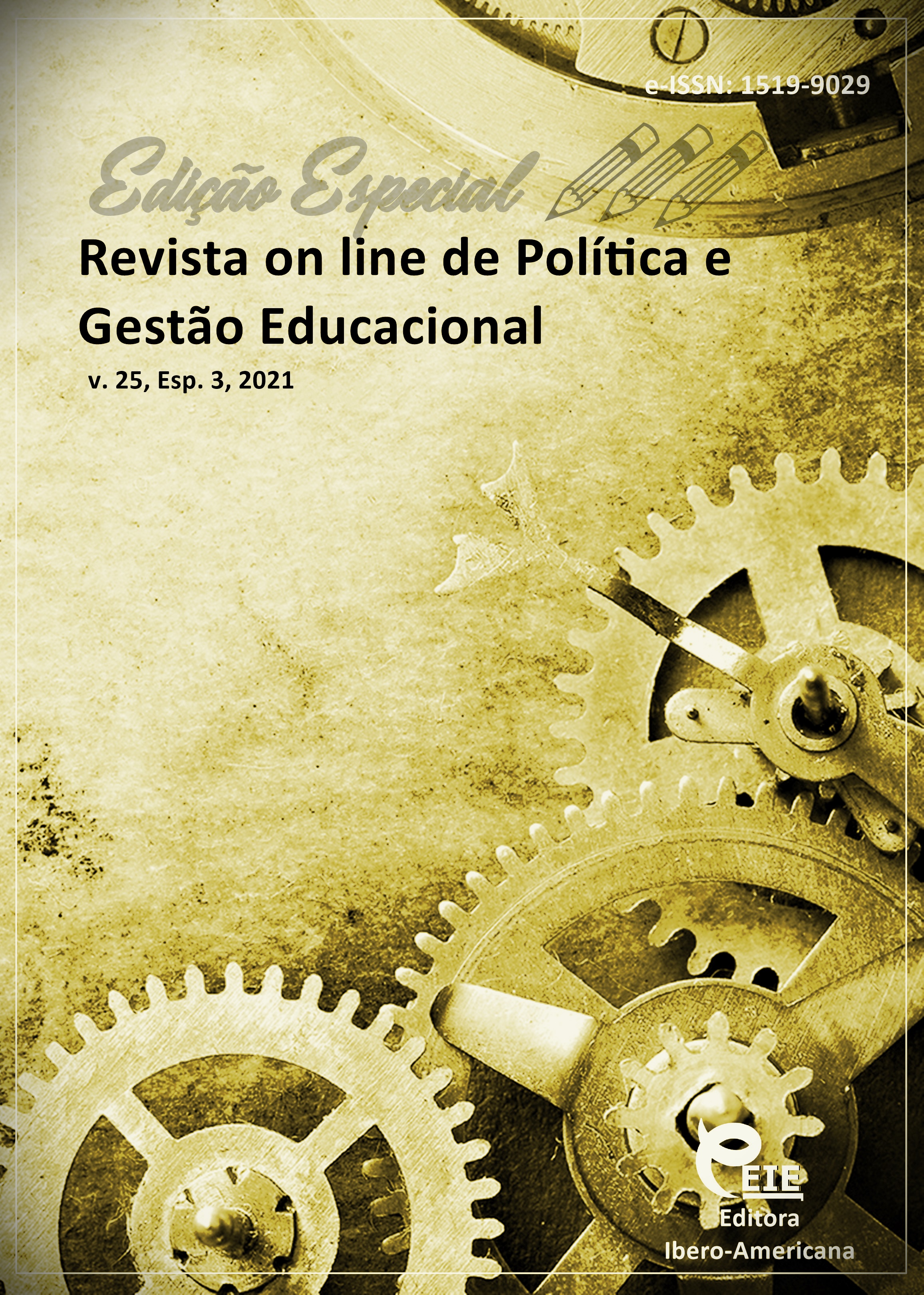Perspectivas para la aplicación de métodos de aprendizaje activo en la educación moderna
DOI:
https://doi.org/10.22633/rpge.v25iesp.3.15587Palabras clave:
Educación moderna, Métodos de aprendizaje activo, Enfoques inovadores, Perspectivas de aplicaciónResumen
El artículo examina las perspectivas de la aplicación de métodos de aprendizaje activo en la educación moderna. La encuesta muestra que las perspectivas de aplicación de métodos de aprendizaje activo en la educación moderna están condicionadas por la influencia de diferentes factores. Estos factores se pueden dividir en varios grupos: organización integral de la enseñanza, construcción de una comunicación adecuada, uso de nuevas tecnologías de aprendizaje, organización de la educación orientada a la personalidad y trabajo en equipo. La encuesta mostró que existen barreras reales y potenciales para que los profesores utilicen métodos de enseñanza innovadores, pero no existe una paradoja seria. No hay duda de que existe un gran interés en las perspectivas y el futuro de la aplicación de los métodos de aprendizaje activo en la educación moderna y su aplicación en la educación. Al elegir un método de enseñanza, se deben tener en cuenta la capacidad de los profesores para utilizar este método y las condiciones locales.
Descargas
Citas
ALIYEV, B.; JABBAROV R. The problem of personality in education.Baku, Educa¬tion, 2008, 136 p. Available: https://lsu.edu.az/new/LSU-Library/l¬b/Stud¬ent_¬/psyc¬holo¬gy.¬php
APEL, H. J. Predavanje, uvod u akademski oblik poucavanja, Zagreb: EruditA,2003. Available: https:¬//libra¬ry.foi.hr/lib/¬knjiga¬.php?B=2¬0&H=&E¬=&V=Y¬&lok
ASTİN, A.W. What matters in college? Four critical years revisited. Jossey-Bass.1993 Available: https://psycnet.apa.org/record/1992-98891-000
AKMHETOVA, G.K. System of Professional Development of Pedagogical Staff in the Republic of Kazakhstan: Update Strategy.Almaty:University of Kazakhstan, 2016, 90 p.
AKSARİN, S. Investigation of the problems of innovative pedagogical activity in the modern vocational education system. Yugorsk State University Bulletin, V.1 (36), p.17-19, 2015. Available: https://cyberleninka.ru/article/n/issledovanie-problem-innova¬tsion¬noy
BEİCHNER, R. J. History and Evolution of Active Learning Spaces. New Directions for Teaching and Learning, 2014, 9-16. Available: http:¬//¬dx.doi.org/10.1002/tl.20081
BOEKAERTS, M.; MUSSO, M.; CASCALLAR, E. Self-Regulated Learning and the Understanding of Complex Outcomes. Educational Psychology International, 2012, 1-81. http://dx.doi.org/10.1155/2012/686385
BONÜELL, C. C.; EİSON, J. A. Active learning: Creating Excitement in the Classroom. ASHE-ERIC, Higher Education Report n. 1.1991, Washington, DC: George Washington University. Available: https://eric.ed.gov/?id=ED336049
BROCKLİSS, L. Curricula. A History of the University in Europe. Cambridge (Reino Unido): Cambridge University Press,1996, Vol. 2., pp.565-620. Available: https:/¬/www-.scirp¬org/(¬S(351jm¬bntv nsjt1aadkp oszje)) /refer ence/Re ferences Paper s.aspx ?ReferenceID=1542008
CLOVİS, L.K.; MARTHA B.A.; PEDRO H.M. Active Teaching and Learning Meth-odologies: Some Considerations, Creative Education, 2015, 6, 1536-1545. Available: http://www¬.scirp.org/ journal /cehttp://d x.doi .org/1 0.423 6/ce.20 15.6 14154
DOYLE, T. Helping Students Learn in a Learner-Centered Envi¬ronment: A Guide to Facilitating Learning in HigherEducation. Sterling, VA: Stylus Publishing. 2008. Available: https://www.¬scirp.org/(S¬(i43dyn45¬teexjx455qlt¬3d2q))/r¬efer¬encaspx?ReferenceID=1542011
FELDER, R.M.; BRENT R. “Learning by Doing.” Chem. Engr.Educ¬ation,2003, 37(4),282-283. Available: https://¬www.¬eng r.ncsu.edu/wp-content/u¬ploads/d¬rive/1¬XaOo9¬WCK¬cMq6-fTcQG¬idOT2¬SDGq¬g70l5/2009-ALpaper(ASQ).pdf
FREEMAN, S.; EDDY, S. L.; MCDONOUGH, M.; SMİT, M. K.; OKOROAFOR, N.; JORDT, H.; WENDEROTH, M. P. Active Learning Increases Students’ Performance in Science, Engineering, and Mathematics. Proceedings of the National Academy of Sciences of the United States of America, 2014, 111, 8410-8415. Available: http://¬www.¬pnas.¬org/-cont¬ent/111/23/8410.full.pdf
HAKE, R. R. Interactive-Engagement vs. Traditional Methods: A Six-Thousand-Student Survey of Mechanics Test. Data for Introductory Physics Courses. American Journal of Physics, 1998, 66, 64. Available: http://dx.doi.org/10.1119/1.18809
HALPERN, D. F.; HAKEL, M. D. Applying the Science of Learning to the University and Beyond: Teaching for Long-Term Retention and Transfer. Change, 2003, 35, 36-41. Available: http://dx.doi.org/10.1080/00091380309604109
INMACULADA C.; MARİA A.; ESTER T. Motivation for the academic reading of future tea¬chers. Educação & Formação Educ. Form., Fortaleza, 2021, v. 6, n. 1, e3535. DOI: https://d¬oi.org/1¬0.25053¬/reduf¬or.v6i1¬.3535
JUNGES, F.C.; KETZER, C. M.; OLİVERA, V. M. Continued teacher training: Ressignficated knowledge and transformed teaching practices. Educação & Formação, Fortaleza, v.3, n.9, p. 88-101, set./dez. 2018. DOI: https:¬//doi.org¬/10.2505¬3/redu¬for.
KRASNOV, S.I. Norms of social design and simulation of innovation. Problems of design in the work of graduate students of OR RAO for 1994 – 1995. Available: ¬https:/¬/cyber¬leni-nka.¬ru/arti¬cle¬/n/instrumentariy-institutsionalnogo-modelirovaniya.
LUCKESİ, C. C. Assessment of school learning: paths taken. Doctoral thesis. Graduate Program in Philosophy of Education. PUC-SP, 1994. Available: http://w¬ww.¬lef¬fa.pro¬.br/te-la4/T¬extos¬
MOCİNİC, S. N. Active teaching strategies in higher education. Metodicki obzori ,2012, 15, vol. 7; 2. DOI: https:/¬¬/doi.org/¬10.32728/mo.07.2.2012.08
MOHAMMED O.; SEİD D.; ABDURAHMAN T. The Practice and Prospects of Active Learning Methods in Wollo University, American Scientific Research Journal for Engi-neer¬ing, Technology, and Scie¬nces, 2020, Volume 65, No 1, pp 1-15.
NAZAROV, A. Modern learning technologies. Textbook. ADPU-publishing house. Baku: 2012, 103 p. Available: http://anl.az/el/Kitab/Azf-269214.pdf
PRİNCE M. J. Does Active Learning Work? A Review of the Research. Journal of Engineering Education,2004, 93, 223-231. Available: http://d¬x.doi.¬org/10.¬1002/¬j.2168-9830-0¬809.x
ROÜE, M. B. Pausing Principles and Their Effects on Reasoning in Science. In F. B. Brawer (Ed.), Teaching the Sciences: New Directions for Community Colleges, 1980, pp. 27-34. San Francisco: Jossey-Bass. Available: http://dx.doi.org/10.1002/cc.36819803106
STİENER-HAMSEY, G. How NGOs react: globalization and education reform in the Caucasus, Central Asia and Mongolia. Kumarskaya press, v.31 (2), p.25-36, 2018. DOI: 10.1111 / j. 1467-873X.2008.00426.x.
TAGUNOVA, I.A.; SELİVANOVA, N.L.; VLEEVA, R.A. The category of upbringing in Russian and western studies. Mathematics Education, V.11(1), p.3-9, 2016. DOI: 10.12973/i ser.201 6.2101a.
ZANCHİN, M. R. Le strategie attive, u AA.VV., Le interazioni educative, Roma: Armando, 2002.
Publicado
Cómo citar
Número
Sección
Licencia
Derechos de autor 2021 Revista on line de Política e Gestão Educacional

Esta obra está bajo una licencia internacional Creative Commons Atribución-NoComercial-CompartirIgual 4.0.
Manuscritos aceitos e publicados são de propriedade da Revista on line de Política e Gestão Educacional. É vedada a submissão integral ou parcial do manuscrito a qualquer outro periódico. A responsabilidade do conteúdo dos artigos é exclusiva dos autores. É vedada a tradução para outro idioma sem a autorização escrita do Editor ouvida a Comissão Editorial Científica.










